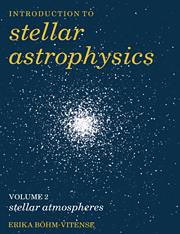Book contents
- Frontmatter
- Contents
- Preface
- 1 Stellar magnitudes and stellar colors
- 2 Stellar spectra
- 3 Temperature estimates for stars
- 4 Basics about radiative transfer
- 5 Radiative transfer in stellar atmospheres
- 6 The depth dependence of the source function
- 7 The continuous absorption coefficient
- 8 The influence of the non-greyness of the absorption coefficient
- 9 The pressure stratification
- 10 Theory of line formation
- 11 The hydrogen lines
- 12 Spectrum analysis
- 13 Basics about non-local thermodynamic equilibrium
- 14 The hydrogen convection zone
- 15 Stellar chromospheres, transition layers, and coronae
- 16 Stellar winds
- Problems
- Appendix LTE model stellar atmospheres
- References
- Index
2 - Stellar spectra
Published online by Cambridge University Press: 08 February 2010
- Frontmatter
- Contents
- Preface
- 1 Stellar magnitudes and stellar colors
- 2 Stellar spectra
- 3 Temperature estimates for stars
- 4 Basics about radiative transfer
- 5 Radiative transfer in stellar atmospheres
- 6 The depth dependence of the source function
- 7 The continuous absorption coefficient
- 8 The influence of the non-greyness of the absorption coefficient
- 9 The pressure stratification
- 10 Theory of line formation
- 11 The hydrogen lines
- 12 Spectrum analysis
- 13 Basics about non-local thermodynamic equilibrium
- 14 The hydrogen convection zone
- 15 Stellar chromospheres, transition layers, and coronae
- 16 Stellar winds
- Problems
- Appendix LTE model stellar atmospheres
- References
- Index
Summary
The spectral sequence
If we look at the spectra of the stars we find that most spectra show a series of very strong lines which can now be identified as being due to absorption by hydrogen atoms. They are called the Balmer lines. Since these lines appeared to be strong in almost all stellar spectra, astronomers started to classify spectra according to the strengths of these lines, even though they did not know what caused them. The spectra with the strongest Balmer lines were called A stars, those with somewhat fainter lines were called B stars, and so on down the alphabet. It later turned out that within one such class there were spectra which otherwise looked very different; there were also stars within one spectral class which had very different colors. Taking this into account, the spectra were then rearranged mainly according to the B – V colors of the stars which did, however, turn out to give a much better sequence of the spectra. Spectra in one class now really looked quite similar. Now the spectra with the strongest Balmer lines are in the middle of the new sequence. The bluest stars have spectral type O, the next class now has spectral type B, and then follow the A stars, the F stars, and then the G, K, and M stars. In Fig. 2.1 we again show the spectral sequence. The bluest stars – the O stars – are at the top. Their Balmer lines are rather weak, as the letter O indicates.
- Type
- Chapter
- Information
- Introduction to Stellar Astrophysics , pp. 15 - 17Publisher: Cambridge University PressPrint publication year: 1989



